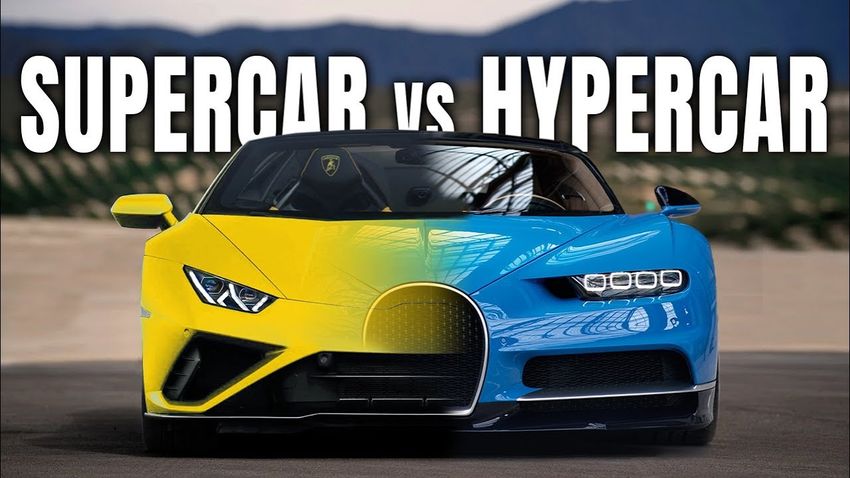Introduction: The World of High-Performance Vehicles 🌟
In the realm of high-performance automobiles, two names often evoke passion and excitement: hypercars and supercars. While both categories represent the pinnacle of automotive engineering, they cater to different performance standards, design philosophies, and exclusivity levels. In this article, we’ll explore what sets hypercars apart from supercars, diving into their performance, technology, design, and even their price tags. Whether you’re an automotive enthusiast or simply curious about these marvels of engineering, read on to discover the nuances that make each category unique! 🚗💨
1. Defining Supercars and Hypercars: An Overview 🏁
Supercars: The Epitome of Performance and Style
Supercars are high-performance vehicles that combine stunning design, powerful engines, and advanced technology. They are built to offer exhilarating speed, precision handling, and an unforgettable driving experience. Typically, supercars are produced in limited quantities and carry a significant price tag, but they remain more accessible than their hypercar counterparts.
Key Characteristics of Supercars:
- Performance: Top speeds typically range from 200 to 220 mph (320-354 km/h).
- Design: Striking aesthetics with aerodynamic curves and aggressive lines.
- Technology: Advanced materials, lightweight construction, and cutting-edge electronics.
- Production: Limited production numbers, but more common than hypercars.
- Price: High-end pricing, yet within reach of a select group of enthusiasts.
Hypercars: The Pinnacle of Automotive Engineering
Hypercars take performance to a whole new level. They are more than just cars; they are engineering masterpieces that push the boundaries of what is possible on four wheels. Often equipped with hybrid powertrains, extreme aerodynamics, and exotic materials like carbon fiber, hypercars are built for speed, exclusivity, and sheer spectacle. They represent the ultimate expression of automotive technology and are produced in very limited numbers.
Key Characteristics of Hypercars:
- Performance: Top speeds often exceed 220 mph (354 km/h) with acceleration figures that leave even the best supercars in the dust.
- Design: Futuristic, innovative, and sometimes radical styling that emphasizes functionality as much as aesthetics.
- Technology: Incorporation of hybrid systems, advanced aerodynamics, and state-of-the-art electronics to optimize performance.
- Production: Ultra-limited production runs that make each model a rare collector’s item.
- Price: Extremely high prices, often in the millions of dollars, reflecting their exclusivity and technological prowess.
2. Performance and Engineering: Powerhouses on Wheels ⚡
Engine Power and Acceleration
Both supercars and hypercars are designed to thrill, but the gap between them often lies in the numbers. Supercars, such as the Ferrari 488 GTB or Lamborghini Huracán, typically harness around 600 to 700 horsepower, delivering blistering acceleration and impressive top speeds. Hypercars, like the Bugatti Chiron or Koenigsegg Jesko, often boast well over 1,000 horsepower and incorporate hybrid systems to push performance even further.
Acceleration Comparison:
- Supercars: Can accelerate from 0 to 60 mph in around 2.8 to 3.2 seconds.
- Hypercars: Often achieve 0 to 60 mph in under 2.5 seconds, thanks to their advanced powertrains and innovative technologies.
Aerodynamics and Lightweight Construction
Aerodynamics plays a crucial role in both categories. Supercars use advanced designs to minimize drag while maximizing downforce, ensuring stability and grip at high speeds. Hypercars, however, take this to the next level. They employ active aerodynamic systems that adjust in real-time to changing driving conditions, and extensive use of carbon fiber reduces weight dramatically. This results in a better power-to-weight ratio, which is key to achieving record-breaking speeds.
Hybrid Powertrains and Advanced Technology
While many supercars rely on naturally aspirated or turbocharged internal combustion engines, hypercars frequently incorporate hybrid technology. This not only increases overall power but also improves efficiency and allows for energy recovery during braking. For example, the McLaren P1 and Porsche 918 Spyder are early examples of supercars that paved the way for hypercars by integrating hybrid systems, thus setting new standards in performance.
3. Design and Exclusivity: Art Meets Engineering 🎨
Styling and Aesthetics
The design of a supercar is all about making a statement. Bold lines, aggressive curves, and sculpted bodies are the norm, ensuring that these cars are as visually captivating as they are fast. Hypercars, on the other hand, often venture into uncharted territory with futuristic designs that are sometimes more radical. Their aesthetics are driven not only by beauty but by function—every curve and surface is optimized for performance.
Notable Examples:
- Supercars: Ferrari 488 GTB, Lamborghini Huracán – Designed to evoke passion and speed.
- Hypercars: Bugatti Chiron, Koenigsegg Agera RS – Designs that challenge conventional automotive norms.
Limited Production and Exclusivity
Exclusivity is another key differentiator. While supercars are limited-production models, hypercars take rarity to the extreme. With production runs often limited to a few dozen units worldwide, owning a hypercar is not just about performance—it’s a statement of status and luxury.
Price and Investment
The cost reflects the technological advancements and exclusivity of these vehicles. Supercars typically fall in the high six-figure range, while hypercars can easily reach into the millions. For many collectors, a hypercar is not just a mode of transportation but an investment that may appreciate over time due to its rarity and desirability.
4. Driving Experience: Beyond Speed and Power 🏎️
Supercars: The Thrill of the Drive
Driving a supercar is an exhilarating experience. They offer an incredible blend of speed, handling, and responsive steering, making every journey an adventure. Supercars are engineered to provide a balance between everyday usability and track performance, allowing drivers to enjoy them on both highways and race tracks.
Hypercars: The Ultimate Adrenaline Rush
Hypercars are designed for those who seek the pinnacle of driving excitement. The experience of piloting a hypercar is often described as otherworldly. With near-instant acceleration, cutting-edge aerodynamics, and the roar of a monstrous powerplant, every drive in a hypercar is an adrenaline rush. However, due to their extreme performance and limited practicality, hypercars are often reserved for special occasions or track days rather than daily driving.
Technology and Driver Assistance
Both supercars and hypercars incorporate advanced driver assistance systems (ADAS) to enhance safety and performance. However, hypercars tend to integrate more sophisticated technologies, including adaptive suspension systems, real-time telemetry, and even AI-driven adjustments to optimize handling. This technological edge helps hypercars maintain superior performance even in unpredictable conditions.
5. Market Impact and Cultural Significance 🌍
Supercars: Symbols of Success and Performance
Supercars have long been symbols of success and the ultimate expression of automotive performance. They are frequently seen in films, advertisements, and at prestigious automotive events, serving as icons of luxury and speed. For many enthusiasts, owning a supercar is a dream that signifies achievement and a passion for performance.
Hypercars: The Future of Automotive Excellence
Hypercars represent the future of high-performance automobiles. They push the boundaries of what is technologically possible and often serve as testbeds for innovations that eventually trickle down to more mainstream vehicles. Their influence extends beyond the automotive industry, inspiring advancements in materials science, aerodynamics, and hybrid technology.
Collectability and Legacy
Both supercars and hypercars are highly collectible. Supercars often have a broader market appeal due to their relative accessibility, while hypercars are coveted by collectors worldwide for their rarity and groundbreaking technology. Over time, these vehicles become part of automotive history, with some models achieving legendary status for their performance and design.
Conclusion: Choosing Between a Supercar and a Hypercar 🔥
In summary, while both supercars and hypercars are engineered for high performance, they serve different purposes and cater to different tastes. Supercars offer an exhilarating driving experience, striking aesthetics, and a blend of performance and usability. Hypercars, meanwhile, represent the absolute pinnacle of automotive engineering, offering unparalleled speed, innovation, and exclusivity.
Whether you prefer the raw, accessible thrill of a supercar or the extreme, almost surreal performance of a hypercar, both categories push the boundaries of what cars can achieve. They remind us that in the world of high-performance vehicles, engineering is not just about speed—it’s about passion, innovation, and the relentless pursuit of excellence. 🚗💨


